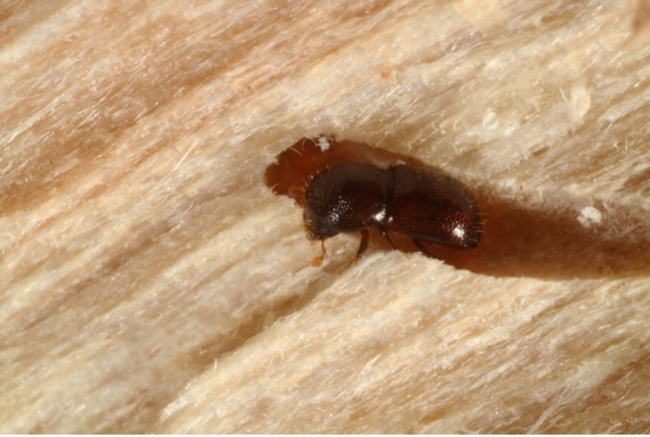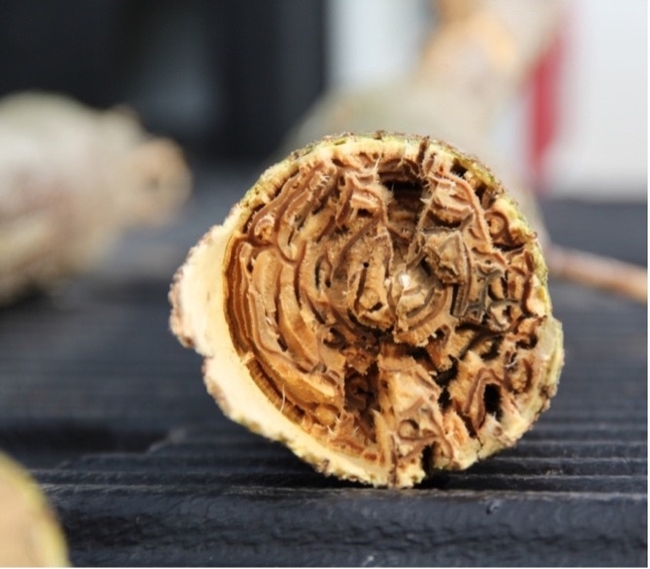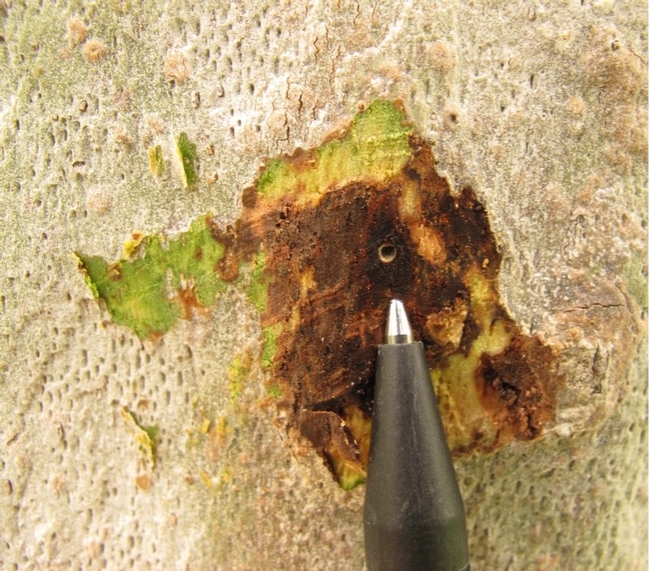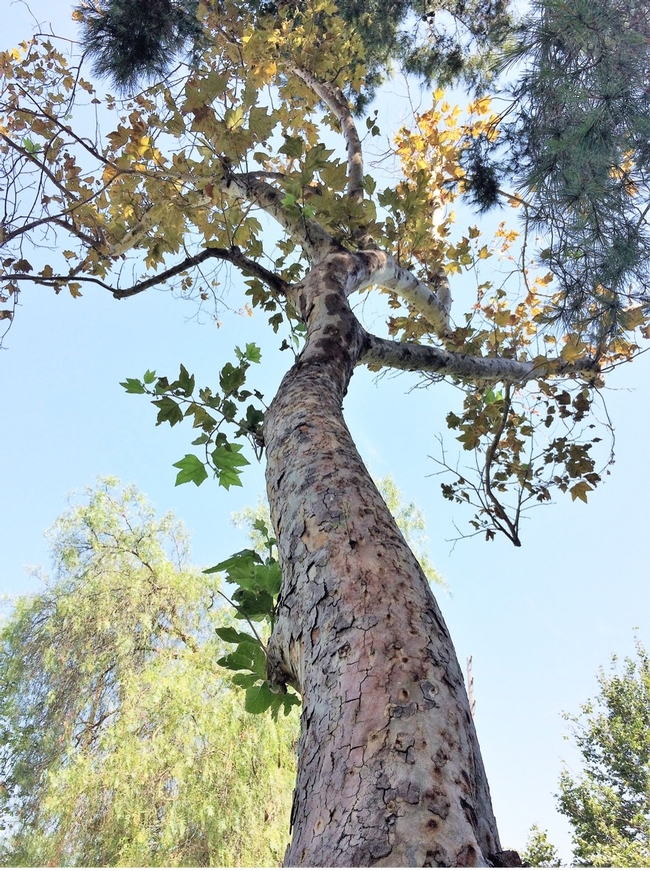Two identical looking species of wood-boring beetles, collectively known as invasive shothole borers (ISHB), have killed thousands of trees in Southern California and pose an ongoing threat to California's urban and wildland forests. These beetles, which are not native to the United States, were first identified in Los Angeles County in 2012 and have since spread to six other counties: Orange, Riverside, San Bernardino, San Diego, Santa Barbara, and Ventura.
Beetles, Fungus, and Impact


As the fungus grows, it colonizes the tree's vascular system, blocking transport of water and nutrients. This causes a disease called Fusarium dieback that can kill branches or entire trees. The beetles and their symbiotic fungi have a wide range of suitable hosts, including more than 65 species of trees found in California. The most highly susceptible trees include many of the species commonly used for landscaping, such as sycamores, oaks, cottonwoods, and box elder trees. ISHB beetles attack healthy trees as well as stressed or diseased trees in a variety of urban, suburban, and riparian settings. Visit www.ishb.org to find the full list of reproductive hosts in California.
Female beetles can fly short distances, allowing the pest-disease complex to spread into new areas near already infested trees. Beetles can also be transported in infested firewood and green waste, leading to spread over much greater distances. While beetles have only been identified in Southern California and the Central Coast to date, further spread throughout much of California is possible.
ISHB-infested trees can quickly become public safety hazards. Trees with heavily infested branches can be especially hazardous, since the combined damage of the fungal disease and the beetle's tunneling activity weakens the wood, causing limbs to break and fall. In addition, severely infested trees will become constant sources of beetles that can disperse and infest neighboring trees. Such “amplifier” trees generally need to be removed completely, while more lightly infested trees can be managed or treated without requiring removal. Therefore, early detection and rapid response is the key to controlling ISHB. Substantial recovery in lightly to moderately infested trees has been observed in some areas where amplifier trees have been removed.
Identifying an ISHB infestation

- Beetle entry holes: When the beetles tunnel into trees they make small, perfectly round holes, each about the size of the tip of a medium ballpoint pen (0.8 mm). (Figure 3)
- Additional signs and symptoms: Entry holes are usually accompanied by one or more of the following signs and symptoms, which vary by the tree species: staining, gumming, white powdery exudate, or frass (boring dust).
- Dieback: Dead or wilting branches can be a sign of a severe infestation. If you see dieback on trees, check for entry holes on the trunk or the branch collars.
In addition to visual inspections, traps using quercivorol, a plant-based lure that attracts the beetles over short distances, can help determine the presence and abundance of beetles in an area. Trapping is especially useful for large or inaccessible areas where regular visual inspections of all the trees are not practical. In those cases, trapping can help determine if ISHB is present in the area and can help focus survey efforts on infested trees. Because the lure has relatively low attractiveness, trapping is not an effective control method for ISHB and is only used for detection purposes.
What Can You Do?
- Keep trees healthy. Proper irrigation and maintenance will keep trees strong and help protect them from ISHB and other pests.
- Prune out infested branches. Removing branches that have clusters of 50 ot more ISHB holes would help control this pest. For trees that undergo heavy pruning every year, like avocado trees, removal of all infested branches is recommended. Tools should be disinfected after pruning by spraying them with a solution of 5% disinfecting bleach or 70% ethanol to avoid spreading the fungal disease to other trees.
- Remove severely infested trees. Unfortunately, severely infested trees (with more than 150 entry holes and ISHB-related dieback) are not likely to survive. These trees should be removed as soon as possible, and the stump should be ground to one inch or less. (Figure 4)
- Manage downed wood. Green waste generated by branch and tree removals should be properly disposed.
- Chipping/grinding to one inch or less kills 99.9% of the beetles. If that is not possible, chipping to three inches or less still will kill 98% of the beetles in the wood. In already infested areas, chipped wood can be used onsite as mulch. However, if working on a newly infested area or if the wood chips will be moved to another area, chipping should be combined with solarization or composting to kill 100% of the beetles. If chipping is not an option, logs can also be solarized or kiln dried to exterminate the beetles.
 Figure 4. California sycamore heavily infested with invasive shothole borers. (Credit: B Nobua-Behrmann, UCCE)
Figure 4. California sycamore heavily infested with invasive shothole borers. (Credit: B Nobua-Behrmann, UCCE) - Solarization involves covering the material with clear plastic tarp and letting the heat from the sun kill the remaining beetles. Chips and beetles should be fully contained by wrapping plastic both underneath and over the material. Chips should remain covered for at least six weeks during the summer months or for at least six months between September and June. The depth of the pile should be no more than 30 inches deep, to ensure even heating.
- Composting, when done correctly, should also kill the remaining beetles in the chips. It is recommended to send infested chips to a professional composting facility that has earned the U.S. Composting Council's Seal of Testing Assurance.
- Prevent the spread. Avoid spreading this pest by not moving firewood or mulch that hasn't been properly solarized or composted. If you must move infested greenwaste (for example, to bring it to a composting facility) make sure the load is tightly covered while in transit.
- Consider chemical control.TreesthatarereproductivehostsforISHB and that show signs of active infestations can be treated with a combination of insecticide and fungicide. The decision to treat a particular tree depends, among other things, on the tree's condition, value, and hazard level. Trees that aren't already infested should be monitored but not treated. There are various chemicaloptionsthatcanbeusedagainstISHB-FD.
- Trunk sprays of a contact insecticide, such as bifenthrin, combined with Bacillus subtilis or tebuconazole (which are fungicides) have been demonstrated to offer some degree of control.
- Systemic soil injections or drenching with the insecticide imidacloprid has also provided control, as has trunk injection with emamectin benzoate (insecticide) combined with tebuconazole or propiconazole (fungicides).
- These pesticides should only be applied by a licenced professional following the instructions on their labels to avoid harming non-target organisms.
Biocontrol options are currently under research. They include the use of natural enemies (such as parasitic wasps from the beetles' point of origin), entomopathogenic fungi (which are fungi that attack insects), endophytes (which are microorganisms that live in the tree that may provide protection) and nematodes. But these biological management options might take time before they are tested and available. Until then, prevention, early detection, and rapid response are our best weapons to keep trees healthy and alive. For more information on invasive shothole borers and their management, visit www.ishb.org.
[Article originally published in the Summer 2021 issue of the Green Bulletin.]
